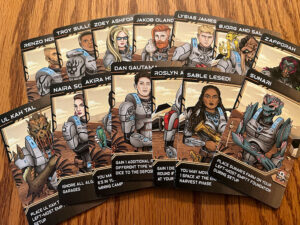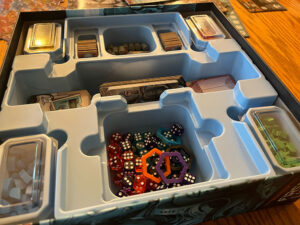 Somewhere in Arizona… on a Tuesday… 5:02 a.m.
Somewhere in Arizona… on a Tuesday… 5:02 a.m.
Chris was positioned toward where the sun would eventually rise, wearing his normal Tuesday safari suit and pith hat, straining to get the best view he could through his binoculars.
“Dude, why did you wak—“ I started, only to be interrupted by a “SHHHHHH” and an evil look.
“You will ruin the surprise. Now be quiet!” he commanded through clenched teeth and pointed to the ground next to him. Like an obedient dog, I took a crouched position where I was directed.
I tried to ask another question, but before I could get a word out, he raised one finger to his mouth and pointed at a box next to him. Barely audible, he muttered “I am here to see them.” I looked at the box. Circadians First Light: Second Edition. To say I was puzzled would be an understatement.
“Ummm, to see… Whom, exactly?”
He looked at me exasperatedly. “The cicadas” he replied.
“The… what?”
He turned to me, clearly frustrated at the attention I required. After taking a deep breath, he explained, “I need to see the cicadas at sunrise… first light, duh. I broke their complex code.” He was beaming with pride. “If I do, they will lead me to the alien ship and I can get off this stupid planet,” he continued. “You know. Like the box promises.”
I stared at him. Then at the box. Then at him again. “Dude, that says Circadians. Not cicadas.”
You know how they say that in space no one can hear you scream. This was the opposite of that.
“NOOOOOOOOOOOOO,” he wailed, calling to mind Vader at the end of Revenge of the Sith.
After uncomfortably watching him cry in the fetal position for what felt like an eternity, it hit me. I knew what had to be done to fix this… to help Chris… to make the world right again.
I grabbed the box and left.
That is the true story of how I received my copy of Circadians First Light.
Gameplay Overview:
Circadians First Light: Second Edition is a worker placement game for one to four players, with games lasting between 60 and 120 minutes. The game uses dice as workers, so, for consistency, I will be calling them dice workers for the remainder of the review.
Circadians First Light is called Second Edition (this is the last time I will mention it is Second Edition) because it includes revised and streamlined terminology and iconography, two new leader cards, the Allies expansion, and two gameplay variants.

A game is played over seven rounds. Each round consists of the following four phases:
- Plan: Reveal the event card and roll and assign your dice to your research base (this is all done behind your screen)
- Execute: In turn order, place one die, or two for the laboratory, on either the station, spaceport, or negotiations board from your garage
- Harvest: Gain resources (there are four types – algae, water, energy, and games) from your harvester and dice assigned to your farm.
- Rest: Retrieve all dice from the station boards, pass the first player marker, and discard dice down to five if you have more than five, contract cards down to eight if you have more than eight.
After seven turns, the game ends and the players tally their scores. Players score points in five ways:
• The Negotiations board
• Fulfilled Contract Cards
• A Harvester on a Gem Cache at the end of the game
• Points from their Research Base
• Unspent Gems
The player with the most points wins. Yay!

Game Experience:
I really liked Circadians First Light. To be fair, I love worker placement games, but this one is special in an already crowded genre. “But Brian, what makes it special?” Good thing my review isn’t over!
First, hiding the placement of your workers behind a screen adds an element that is not often considered in worker placement games. Yes, there is the usual “will my opponent take the location I want?” tension; however, there is the added level of “how many workers will my opponent use this turn?” Escalating this tension is the fact that the actual number of locations are severely limited. I mostly play Circadians with two players. At that player count both the Foundry (allows you to buy a garage so you can place more workers) as well as the Laboratory (allows you to build a farm to generate more resources) locations both have only one space. Luckily, you can assign a die to HQ and, along with a small bonus, you will be able to go first at the start of the next turn before the first player (at the cost of having the dice do nothing but sit in HQ THIS turn). Remember, there are only seven rounds in a game. Yikes!
Another interesting decision this game presents is how to use your dice. Should they be placed in garages so they can be used as a worker or should they “stay home” and generate resources? Unlike many worker placement games, going to a location does NOT give you the reward for free. You must also pay resources to receive the benefit of that location (except the market, which allows you to trade resources for other resources). Balancing sending out your workers versus keeping them on your Research Base to generate resources is key to a game-winning strategy. Too many resources and you may have wasted valuable moves that could have generated points, but if you do not have enough resources you will not be able to pay the costs for the spaces you would like to utilize.

The value of the die will also influence your decisions. For example, there are three slots on the Foundry board. A one or two value die can buy the left slot, three to four can buy the middle slot and five or six can buy the right slot. For the Control Room, the value of the die placed determines the direction you can move your harvester on the Planet board. Finally, the resources generated at your Research Base generate more resources at higher die values. This adds a third level of complexity to deciding when and where to play your dice.
Fourth, I love that the two main ways to score points, either when completing contracts at the spaceport or negotiating with the three factions, require you to commit a die permanently. You are not limited to the three dice provided during setup as you can use the Academy board to recruit new dice; however, this uses up another turn in a tight seven round game. Planning when to score these two boards can be difficult.
For completing contracts, the difficulty is that you might not be able to play the die value that you have because its slots are full (there are three slots for each allowed die value, with the allowed die values decreasing with lower player counts). That being said, contracts can be rewarding beyond points. Many of them grant you special abilities during the game and others provide bonus point opportunities at end game.
For negotiations, there are three issues to consider – which faction you want to negotiate with (each has a special power that is immediately triggered), are there slots available at the faction and will you suffer a setback (a penalty for two dice of the same or too high of a value dice at the same faction). Negotiation points can be really big, but they can be expensive, especially triggering a setback.

Finally, there are the leader cards. They can be quite powerful, sometimes to the point where you think that you lost the game because of the leader your opponent has and not because your all algae, all day strategy was terrible. It reminded me a bit of Marco Polo in regard to the leader envy this game caused. Unfortunately, all is not rosy with the leaders…
I only have two issues with Circadians First Light, and only one is gameplay related. While I do enjoy the leaders, I do not think that they are balanced as well as they could have been. There are several leaders that give permanent bonuses, such as the ability to move your harvester for free every turn or an extra three value die every turn and does not count toward your die limit. Then there are the leaders with situational powers, like treating a setback as a positive (what if you never trigger a setback) or ones, twos and threes count as sixes for your farms (what if you don’t need any resources this turn or you do not roll a one, two or three). I would take the first two leaders over the second set of leaders every game. Luckily, you are dealt three leaders at the start of the game and can choose one. I just wish EVERY option was more “whoa” then “meh.”
My second issue is with the art. I love the game. I do not like the art. The artist for Hadrian’s Wall did the art for this game. I did not mind the art for Hadrian’s Wall. In Circadians, it was as noticeably worse. For one, everyone looks like the either saw a ghost or like they are looking through you. Their eyes are weird. Second, it looks like the characters were drawn and then a computer inserted them over the background. I am not an artist, so I cannot explain it. I can just tell you that I love the game, not the art.
Final Thoughts:
SJ Macdonald has skyrocketed to the top of my favorite designers. Circadians First Light is his first solo design credit. SJ and Shem Phillips have also created the West Kingdom Trilogy (Paladins, Architects, and Viscounts). All four of these games are in my collection.
Circadians First Light is the only worker (dice) placement of those games. Assigning your dice behind your screen while also deciding if they will be used to work versus generate resources is a unique and engaging mechanism. I also appreciated that the multiple scoring paths allow you a freedom to pursue how you want to play the game, increasing replay value. Circadians First Light is a must-play in my mind, especially if you enjoy worker placement games.
Final Score: 4.5 Stars – An excellent dice placement game that is unique enough to remain in my collection.
 Hits:
Hits:
• Hidden dice placement
• Severely limited selection of worker locations
• Deciding if a die should be used as a worker vs. resource generator
• Impact a die value has on your decisions
• Choosing when/if to score on Negotiation or Spaceport Boards
• Leader cards
Misses:
• Leader card balance
• The art





















